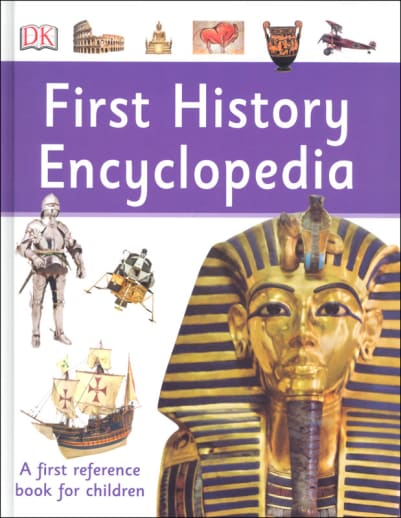From the Stone Age (evolutionary) to Ancient worlds, from medieval times to the 21st century, this DK book is an appealing addition to your history class—or just for fun. Heavily dependent on photographs, the pages educate and stimulate interest. The text also engages young minds. Each 2-page spread provides a 1/4-inch type font paragraph for younger readers. Then follows multiple small paragraphs perfect for older kids or adults to read aloud. At the bottom of each page, you'll find a question (the answer is upside down). “Did You Know" buttons provide extra fascinating facts. 136 pgs, hc.
First History Encyclopedia
SKU
080245
ISBN
9781465481436
Grade K-3
Secular
Non-Consumable
These icons are designed to help you quickly understand and learn important information about our products.
Teaching Method
Traditional
Teacher-centered curriculum commonly used in classrooms that may include a text, teacher manual, tests, etc.
Charlotte Mason
A methodology based on the work of a 19th century educator who maintained that children learn best from literature (Living Books), not textbooks.
Classical
A methodology based on the Latin Trivium (three stages of learning), including the grammar stage (memorization and facts), logic stage (critical thinking), and rhetoric stage (developing/defending ideas).
Unit Study
A thematic or topical approach centered around one topic that integrates multiple subject areas.
Montessori (Discovery)
A methodology based on the work of a 20th century educator that emphasizes student and sensory-driven discovery learning and real-life applications.
Other
Other methodologies
Religious Content
Secular
Contains content contrary to common Christian beliefs (i.e. evolution).
Neutral
Avoids religious or theoretical topics or presents multiple viewpoints without preference.
Christian/Religious
Faith-based or including instructional religious content.
Learning Modality
Auditory
Learns through listening, talking out loud or reading out loud.
Visual
Learns through seeing, prefers written instructions and visual materials.
Kinesthetic/Tactile (Hands-On)
Learns through moving, doing and touching.
Multi-Sensory
Curriculum that employ a variety of activities/components.
Presentation
Sequential
Curriculum progresses through well-defined learning objectives. Emphasizes mastery before moving to the next topic.
Spiral
Topics and concepts are repeated from level to level, adding more depth at each pass and connecting with review.
Conceptual/Topical
Focus is on the “why,” often with a unifying concept as well as specific skills; coverage may be broader.
Teacher Involvement
Low Teacher Involvement
Student-led materials; parent acts as a facilitator.
Medium Teacher Involvement
A mix of teacher-led time and independent student work.
High Teacher Involvement
Teacher-led lessons; may utilize discussions, hands-on activities and working together.
Additional Materials Required
No other materials needed
Everything you need is included.
Other Materials Required
There are additional required resources that are a separate purchase.
Other Materials Optional
There are additional resources mentioned or recommended but are not absolutely necessary.
Consumable
Consumable
Designed to be written in; not reusable.
Non-Consumable
Not designed to be written in; reusable.
Our Price
$16.99 $16.99 $12.50
Rainbow Savings: $4.49
Description
Publisher's Description of First History Encyclopedia
Key history topics are simply explained in this friendly and informative reference book.
First History Encyclopedia covers everything a child needs to know about historical events. It follows the curriculum for grades 1 through 6 and provides a strong foundation for history learning through the rest of the school years. It's the perfect homework help book to support children as they begin to learn about history.
This history book is part of DK's best-selling First Reference series. It introduces exciting areas of history that will get kids hooked on learning about the past, including the Romans, Ancient Egypt, the Vikings, World War I, and World War II.
Details
| Product Format: | Hardcover |
|---|---|
| Grades: | K-3 |
| Brand: | DK Children |
| ISBN: | 9781465481436 |
| Length in Inches: | 11.25 |
| Width in Inches: | 8.75 |
| Height in Inches: | 0.625 |
| Weight in Pounds: | 1.75 |
Videos
Reviews

